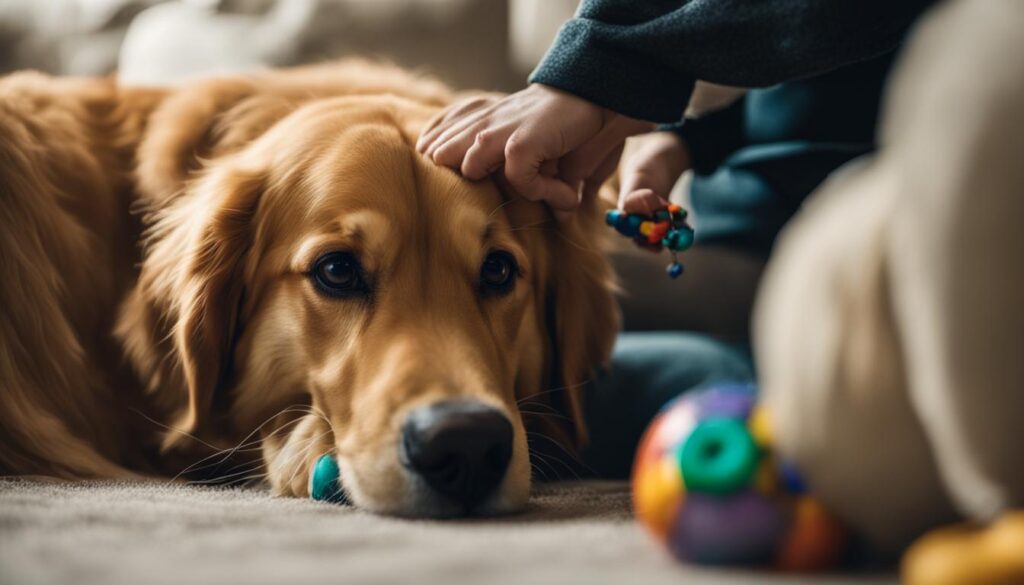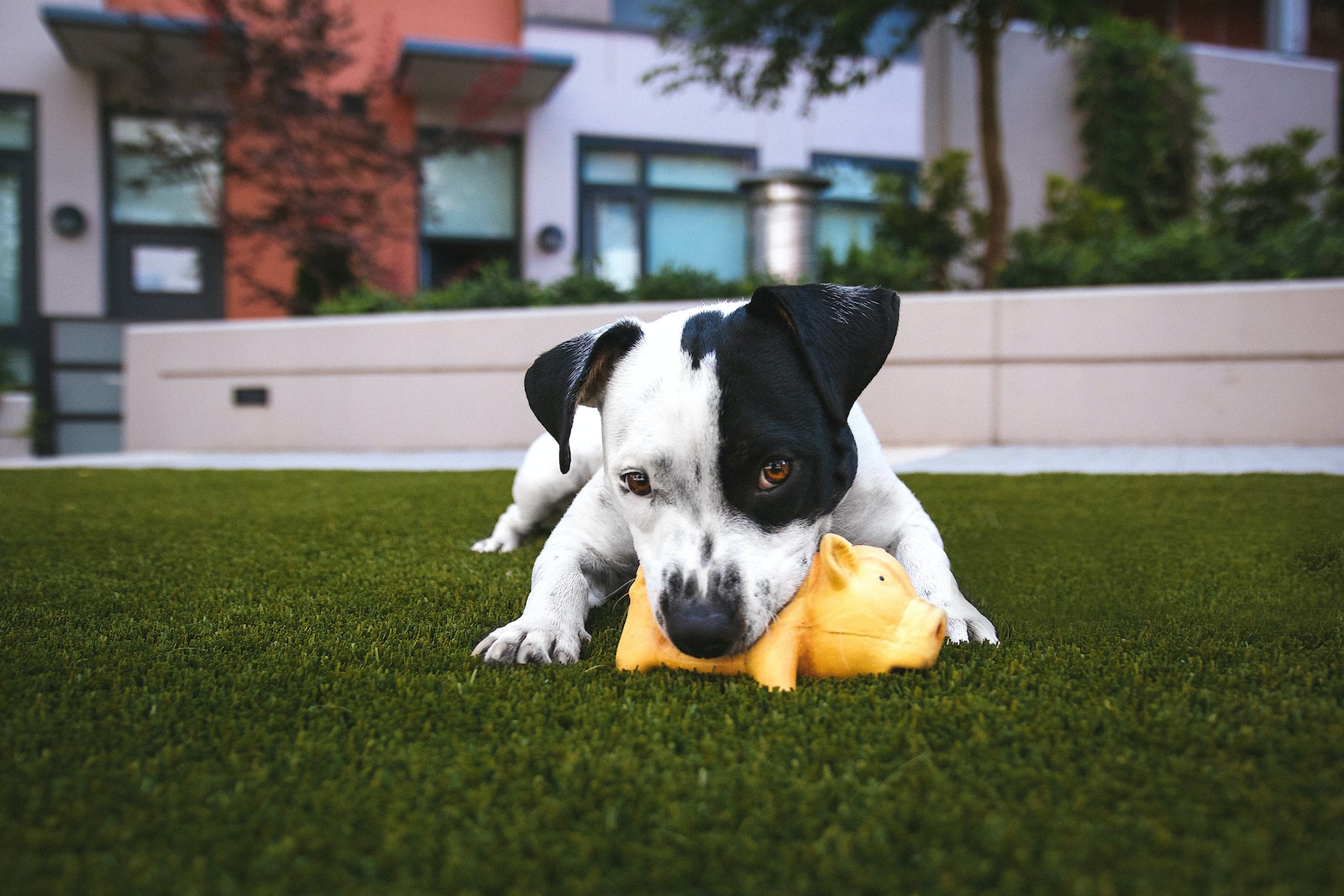Puppies are adorable bundles of energy and curiosity. They love to explore the world around them, and sometimes, that exploration involves biting. But why do puppies bite? Understanding the reasons behind this behavior is crucial for responsible pet owners who want to ensure a happy and well-behaved puppy.
When puppies bite, it’s often because they are in a teething phase or trying to initiate play. They explore their surroundings with their mouths, much like human babies. Additionally, biting can be a form of communication for puppies, expressing their needs or desires.
It’s important to note that while biting is a natural behavior for puppies, it’s essential to teach them appropriate bite inhibition and redirect their biting onto suitable objects. This helps prevent accidental injuries and ensures that the puppy grows into a well-mannered adult dog.
- Bite Inhibition: Teach Your Puppy to Be Gentle
- Teaching Your Puppy That Teeth Don't Belong on Human Skin
- When Does Mouthing Become Aggression?
- Adequate Exercise: One of the Best Ways to Stop Puppy Biting
- Engage in a Training Session to Stop the Nipping
- Teach Leave It
- Don't Get Frustrated When Your Puppy Bites You
- Conclusion
- FAQ
- Source Links
Key Takeaways:
- Understanding why puppies bite is crucial for responsible pet owners.
- Puppies bite to explore, teethe, or communicate their needs.
- Teaching bite inhibition and redirecting biting behavior is necessary.
- Provide appropriate chew toys to satisfy their need to explore with their mouths.
- Seek professional advice if the biting behavior becomes aggressive or persists.
Bite Inhibition: Teach Your Puppy to Be Gentle
One of the key aspects of managing puppy biting is teaching bite inhibition, which refers to a dog’s ability to control the force of their mouthing. Puppies naturally learn bite inhibition through play with other puppies, where they learn to adjust the intensity of their bites to avoid causing harm. As an owner, you can simulate this learning process by allowing your puppy to mouth on your hands during play. However, it’s important to set boundaries and teach your puppy to be gentle.
When your puppy bites too hard, yelping or making a high-pitched noise can help simulate the reaction of another puppy, signaling that their bite was too rough. This can startle the puppy and teach them that their biting behavior can cause discomfort. Additionally, you can use a time-out procedure by ending the play session or leaving the room if the biting continues. By consistently reinforcing these consequences for rough biting and rewarding gentle behavior, you can gradually teach your puppy to use a softer approach when mouthing.
It’s important to note that puppies go through different phases of biting as they grow and explore the world around them. At around 8 to 10 weeks of age, puppies may start exploring the environment with their mouths and may bite more frequently. This is a normal part of their development, and consistent bite inhibition training can help them learn appropriate boundaries and control their biting behavior. Remember to be patient and consistent in your training efforts, as it may take time for your puppy to fully grasp the concept of gentle mouthing.
| Phase | Age | Behavior |
|---|---|---|
| Exploratory Phase | 8 to 10 weeks | Increased mouthing and biting as they explore their environment |
| Teething Phase | 3 to 6 months | Intense biting and chewing as their adult teeth come in |
| Adolescence Phase | 6 to 18 months | Increased biting tendencies as they test boundaries and assert dominance |
Table: Phases of Puppy Biting
Understanding these phases can help you navigate the different stages of your puppy’s development and tailor your training approach accordingly. By focusing on bite inhibition and consistently reinforcing gentle behavior, you can help your puppy develop appropriate biting behavior and strengthen the bond between you.
Teaching Your Puppy That Teeth Don’t Belong on Human Skin
Puppies can often exhibit biting behaviors, especially during their teething phase. To prevent them from biting human skin, it’s important to provide them with appropriate alternatives and redirect their attention. Here are some tips and solutions to help address puppy biting:
- Provide chew toys and bones: Give your puppy plenty of interesting toys to chew on. This will help satisfy their teething needs and divert their attention away from biting human skin.
- Distract with treats and non-contact play: When your puppy starts mouthing on your hands, try distracting them with treats or engaging them in non-contact forms of play like fetch or tug-of-war. This will redirect their attention and teach them that biting human skin is not acceptable.
- Encourage play with other puppies or adult dogs: Socializing your puppy with other dogs in a supervised and controlled environment can help teach them appropriate biting behavior. They can learn valuable lessons from playing with other dogs and adjust the intensity of their bites to avoid causing harm.
Remember, consistency is key when teaching your puppy that teeth don’t belong on human skin. Stay patient, provide positive reinforcement, and redirect their biting behavior onto appropriate alternatives. By following these tips and solutions, you can help your puppy learn and develop better biting habits.
Real-Life Example:
“My puppy used to bite my hands all the time, and it was becoming quite frustrating. But after providing her with a variety of chew toys and bones, she quickly learned to redirect her biting behavior. Now, whenever she feels the urge to bite, she immediately grabs one of her toys instead. It’s been a great solution to teach her that teeth don’t belong on human skin.”
By implementing these puppy biting tips and solutions, you can create a safe and enjoyable environment for both you and your furry friend. Remember to be patient, consistent, and provide plenty of positive reinforcement throughout the process. With time and proper training, your puppy will learn to control their biting behavior and develop into a well-behaved companion.
When Does Mouthing Become Aggression?
Mouthing is a natural behavior for puppies as they explore the world and interact with their environment. However, it’s important to recognize when mouthing crosses the line into aggression. Aggressive biting can be a sign of fear, frustration, or a lack of socialization. It’s crucial to address these issues promptly to prevent them from escalating into more serious problems. Recognizing the signs of aggression in a puppy’s behavior is essential for determining when mouthing has become a cause for concern.
One key indicator of aggressive biting is the puppy’s body language. If the puppy’s body becomes tense and rigid, with stiff movements and a focused stare, it may be acting out of fear or aggression. Growling, snarling, and showing teeth are also signs of more than just playful mouthing. Additionally, if the puppy consistently bites with force and does not respond to redirection or positive training techniques, it may be exhibiting aggressive behavior.
If you notice any signs of aggression in your puppy’s mouthing behavior, it is recommended to seek the help of a professional dog trainer or behaviorist. They can assess the situation, provide guidance on how to address the aggression, and develop a personalized training plan to help correct the behavior. Early intervention and proper training are key to preventing aggression from escalating and ensuring a safe and harmonious relationship between you and your puppy.
| Signs of Aggressive Biting | Signs of Playful Mouthing |
|---|---|
| Body becomes tense and rigid | Relaxed body language |
| Stiff movements and focused stare | Wiggly body and playful hops |
| Growling, snarling, and showing teeth | Gentle bites with a soft mouth |
| Bites with force and does not respond to redirection | Adjusts bite intensity and responds to redirection |
Adequate Exercise: One of the Best Ways to Stop Puppy Biting
When it comes to addressing puppy biting behavior, providing adequate exercise is a powerful tool. Puppies often resort to biting when they have excess energy to burn off. Engaging them in structured games like fetch or using a flirt pole can help them release that energy in a positive way while redirecting their focus. By incorporating regular exercise sessions into your puppy’s routine, you can help reduce their biting tendencies and promote better behavior overall.
Exercise should be tailored to your puppy’s age and breed. For example, high-energy breeds may require more vigorous activities, such as running or playing in a larger outdoor space. On the other hand, smaller or brachycephalic breeds may benefit from shorter, more frequent play sessions that are less physically demanding. It’s important to strike a balance between providing enough exercise to tire your puppy out without overexerting them or causing any harm.
In addition to physical exercise, mental stimulation is also essential for managing and reducing puppy biting. Providing interactive toys, puzzle feeders, and training sessions can help engage your puppy’s mind and redirect their energy. Teaching them new commands and tricks not only provides mental stimulation but also helps establish boundaries and reinforce positive behavior. With consistent exercise and mental enrichment, you can effectively address and curb puppy biting tendencies.

Incorporating Structured Playtime
One effective way to provide adequate exercise for your puppy is through structured playtime. This involves setting aside dedicated periods of time for engaging activities that help burn off excess energy. Consider the following ideas:
- Play fetch in a safe and secure area, making sure to use toys appropriate for your puppy’s size.
- Invest in a flirt pole, which is a long pole with a lure attached to the end. This mimics the movement of prey and engages your puppy’s natural chase instinct.
- Take your puppy for walks or hikes, gradually increasing the duration and intensity as they grow older.
Mental Stimulation and Training
Besides physical exercise, mental stimulation is crucial for a well-rounded approach to addressing puppy biting. Incorporate the following activities into your puppy’s routine:
- Use interactive toys that require problem-solving skills, like treat-dispensing puzzles or Kong toys filled with peanut butter or treats.
- Teach your puppy new commands, such as “sit,” “stay,” or “leave it.” This not only provides mental stimulation but also establishes boundaries and redirects their focus.
- Engage in short training sessions throughout the day, using positive reinforcement techniques like treats and praise.
Consistency is Key
Remember, consistency is key when it comes to addressing puppy biting through exercise and mental stimulation. Set a regular schedule for playtime and training sessions, and stick to it. This will help establish a routine for your puppy and ensure they receive the physical and mental stimulation they need to thrive. With patience, persistence, and a well-rounded approach, you can effectively address and manage puppy biting behavior.
Engage in a Training Session to Stop the Nipping
When puppies start biting, engaging them in a training session can be an effective way to redirect their behavior. This not only provides mental stimulation but also allows you to reward the puppy for positive behavior. Teaching basic commands like sit and stay can help calm the puppy down and create positive experiences with rewards and treats. It’s important to be consistent and practice these training sessions regularly to reinforce desired behaviors.
One training exercise you can try is the “time-out” method. When your puppy bites too hard, say “ouch” in a high-pitched voice to mimic the yelp of another puppy. Then, remove your hand or attention from the puppy for a short period of time. This teaches the puppy that biting too hard leads to a loss of playtime or attention.
You can also use positive reinforcement to teach your puppy not to bite. Whenever your puppy is playing gently or not biting, praise and reward them with a treat or a toy. This reinforces the desired behavior and helps your puppy understand what is expected of them.
quote: “Positive reinforcement and consistency are key in teaching your puppy not to bite.”
Teach Leave It
Teaching puppies the “leave it” command is an effective way to stop biting behavior. This command helps them understand restraint and learn not to grab or bite onto objects or hands. The training process involves gradually introducing the cue word “leave it” while withholding rewards when the puppy tries to bite. With consistent practice, the pup learns to leave certain items alone when commanded, which can be applied to redirecting biting behavior.
Here’s a step-by-step guide on how to teach “leave it” to your puppy:
- Start with a treat in one hand and close your fist.
- Show your closed fist to your puppy and say “leave it”.
- Wait for your puppy to stop trying to get to the treat and reward them with a different treat from your other hand.
- Repeat this process several times until your puppy understands that “leave it” means they shouldn’t go for the treat in your closed fist.
- Once your puppy consistently leaves the treat in your closed fist, add the verbal cue “leave it” just before showing them your closed fist.
- Gradually increase the difficulty by placing the treat on the ground or using more enticing objects.
- Practice “leave it” in different environments with various distractions to reinforce the command.
Remember to be patient and consistent during the training process. With time and practice, your puppy will learn to control their biting behavior and respond to the “leave it” command.

Common Mistakes to Avoid
While teaching “leave it” to your puppy, it’s important to avoid these common mistakes:
- Raising your voice or using force: Punishing your puppy for not obeying the “leave it” command can create fear and confusion, making the training process less effective.
- Being inconsistent: Make sure to use the verbal cue “leave it” consistently and follow through with rewarding your puppy when they respond correctly.
- Skipping steps: It’s crucial to start with closed fists and gradually increase the difficulty. Skipping steps can lead to confusion for your puppy.
- Not providing alternate rewards: When your puppy successfully leaves the desired object, offer them a different treat or a toy as a reward.
- Not practicing in different environments: It’s important to practice “leave it” in various settings to help your puppy generalize the command.
By avoiding these common mistakes and following the step-by-step training process, you can effectively teach your puppy the “leave it” command and redirect their biting behavior.
Don’t Get Frustrated When Your Puppy Bites You
Dealing with a biting puppy can be frustrating, but it’s important to stay calm and patient. Remember, biting is a normal behavior for puppies as they explore their environment and learn about their surroundings. Getting frustrated can actually reinforce the biting behavior, so it’s essential to approach the situation with a positive mindset.
One way to address puppy biting is by redirecting their attention onto appropriate alternatives. When your puppy starts to bite, gently remove your hand or body part from their mouth and offer them a chew toy or bone instead. This teaches them that it’s acceptable to bite on these items but not on human skin. Consistency is key, so make sure to provide plenty of interesting and engaging toys to keep your puppy occupied.
Another effective strategy is to use positive reinforcement. Whenever your puppy shows gentle play behavior or refrains from biting, praise them and offer a treat or verbal reward. This helps them associate good behavior with positive outcomes. Additionally, engaging in regular training sessions can help redirect your puppy’s biting tendencies and teach them other commands and behaviors.

Quotes
“Staying calm and redirecting your puppy’s attention onto appropriate toys can help manage and reduce biting behavior.” – Dr. Sarah Anderson, Veterinary Behaviorist%
“Consistency and positive reinforcement are key in teaching puppies appropriate biting behaviors.” – Karen Smith, Professional Dog Trainer%
Helpful Tips to Stop Puppy Biting
- Provide plenty of appropriate chew toys and bones for your puppy to bite on.
- Redirect their attention onto toys whenever they start to bite on human skin.
- Use positive reinforcement by praising and rewarding good behavior.
- Engage in regular training sessions to teach your puppy other commands and behaviors.
| Biting Behavior | Appropriate Response |
|---|---|
| Playful mouthing on hands or arms | Gently remove your hand and offer a chew toy instead. |
| Hard bites or aggressive behavior | Yelp, withdraw attention, and seek professional help if necessary. |
| Gentle play behavior or refraining from biting | Praise and reward your puppy with treats or verbal praise. |
Conclusion
Puppy biting is a common behavior that owners need to address in order to prevent it from becoming a long-term issue. By understanding the reasons behind puppy biting behavior and implementing appropriate training techniques, you can effectively manage and reduce biting incidents.
Teaching your puppy bite inhibition is crucial. This involves teaching them to control the force of their mouthing, just like they learn from playing with other puppies. Gentle play and positive reinforcement can help replicate this learning process and teach puppies to adjust the intensity of their bites to avoid hurting others.
In addition to bite inhibition, redirecting biting behavior onto appropriate toys is important. Providing your puppy with plenty of interesting toys and engaging them in non-contact forms of play can help divert their attention and prevent them from mouthing on human skin.
Remember, patience and consistency are key when addressing puppy biting. It’s crucial not to get frustrated when your puppy bites, as this can reinforce the behavior. Instead, remain calm, use positive reinforcement, and seek professional advice if needed. With your guidance and a safe environment, your puppy can learn appropriate biting behaviors and become a well-behaved companion.
FAQ
Why does my puppy bite?
Puppies bite as part of their natural behavior. They explore the world with their mouths and also play and chew. It’s important to teach them bite inhibition and redirect their biting onto appropriate toys.
How can I teach my puppy bite inhibition?
Puppies learn bite inhibition through play with other puppies. You can simulate this by allowing your puppy to mouth on your hands during play. If their bites become too hard, yelp or use a time-out procedure to teach them gentleness.
What should I do if my puppy bites my skin?
It’s important to teach your puppy that teeth should not be used on human skin. Provide them with appropriate chew toys or bones and redirect their biting behavior onto those toys instead.
How can I tell if my puppy’s biting is normal mouthing or aggression?
Normal mouthing is usually accompanied by a relaxed body and face. Aggressive biting may be accompanied by tension and aggressive body language. If the biting becomes aggressive or persists, seek the help of a professional trainer or behaviorist.
How can exercise help with puppy biting?
Excess energy can contribute to biting behavior. Engaging your puppy in structured games like fetch or using a flirt pole can help burn off energy and redirect their focus.
How can training sessions help with puppy biting?
Training sessions provide mental stimulation and allow you to reward positive behavior. Teaching basic commands like sit and stay can help calm your puppy and create positive associations.
How can I teach my puppy the “leave it” command?
Gradually introduce the cue word “leave it” and withhold rewards when your puppy tries to bite. With consistent practice, they will learn to leave certain items alone when commanded, which can help redirect their biting behavior.
What should I do when my puppy bites me?
Stay calm and redirect their attention onto appropriate alternatives. Frustration can reinforce the biting behavior. Use positive reinforcement and provide plenty of toys and mental stimulation to keep your puppy engaged.
How can I stop my puppy from biting?
By teaching bite inhibition, providing appropriate chew toys, engaging in training sessions, and using the “leave it” command, you can help manage and reduce puppy biting behavior. Patience and consistency are key.




